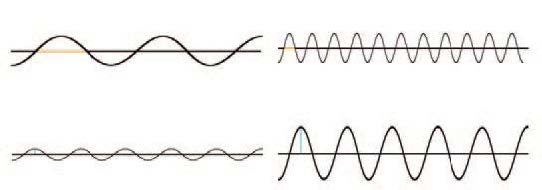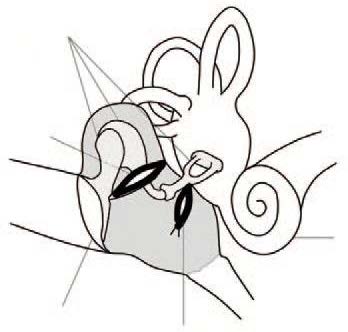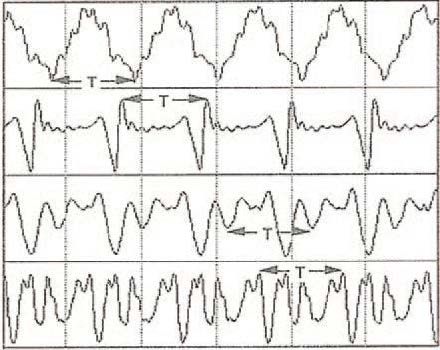THE SMALLEST MUSCLES MAKE THE BIGGEST DIFFERENCE IN BEHAVIOR AND COMMUNICATION
BY ROBIN ABBOTT, MS, OTR/L
Often, therapy for children with special needs involves strengthening muscles. But, unknown to most parents and even some practitioners, two of the smallest muscles in the body can have an extraordinary impact on communication and behavior; those muscles are the tensor tympani and the stapedius muscles of the inner ear. The tensor tympani helps to pro tect our hearing, and its malfunction can result in hyper-sensitivity to sound, what practitioners call auditory defensiveness. The stapedius muscle helps the ear "zoom in" on specific sounds, most notably the sound of other's voices. It influences receptive and expressive communication well beyond the actual words chosen to communicate.

Caregivers with an understanding of how sound influences communication and behavior can meet a child's specific needs more directly, because they can better put themselves "in their child's shoes." To understand auditory function, it is helpful to first review the basics of sound. You might remember from physics class that all sound is composed of the compression and expansion of air waves. This is why there is no sound in outer space; there's no air to compress or expand. But here on Earth, the frequency of the air waves how many wave peaks hit the ear drum per second – determines the pitch of the tone the ear hears. Higher frequencies have higher pitches and lower frequencies have lower pitches.

Top: Low-pitched sound, High-pitched sound. Bottom: Quiet sound, Loud sound (same pitch)
FIGURE 1: SOUND WAVES: All sound is composed of the compression and expansion of air waves.The frequency of the air waves determines the pitch of the tone the ear hears.
When a sound of a given frequency arrives at the ear drum, the ear drum vibrates at that frequency. These vibrations are carried through three interconnected bones, to another membrane that transmits the vibrations to the cochlea. In the cochlea, vibrations transform into a neural impulses that travel to the brain. Not only do nerves run from the ear into the brain to perceive sound, but nerves also carry messages from the brain back to the ears to control the tensor tympani and stapedius muscles.
Why is this necessary? One function of tensing of the tensor tympani muscle is the protection of our hearing. This muscle is connected to the malleus, one small bone of the inner ear that connects to the ear drum. When it tenses, it dampens the intensity of vibration of the ear drum so that the bones of the ear don't transmit overly-intense vibrations which could damage the very sensitive cochlea. Your brain reflexively contracts this muscle when you speak, to protect your hearing against your overly-loud voice.

FIGURE 2: THE BONES AND MUSCLES OF THE MIDDLE EAR: When the tensor tympani tenses, it prevents overly-intense vibrations which could damage the very sensitive cochlea.
Some children will cover their ears to sounds others can tolerate, or have significant behavioral problems in noisy environments. It may well be that their tensor tympani muscle is not doing its job. Because a functional tensor tympani protects the ear against damage, and damage to any part of the body creates pain signals in the brain, dysfunction in this muscle can create discomfort or pain for a child. Temple Grandin, a college professor and person with autism, describes her struggle with noise, "When I was little, loud noises were a problem, often feeling like a dentist's drill hitting a nerve." It is likely her tensor tympani muscle was not functioning effectively.
The other muscle controlled by the nerves that run from the brain to the ear is the stapedius muscle. This muscle also controls the vibration of the ear bones, to create what auditory-therapy pioneer Paul Madaule calls our "auditory zoom" – the ability to filter out background sounds, to selectively focus on the sounds our brain feels are important. When you listen to a friend's story in a noisy restaurant, the stapedius muscle contracts with a specific amount of force, to encourage the bones of your ear to vibrate more readily at the frequency of your friend's voice. And thus, not vibrate at the frequencies of other noises in the room. Undesirable sound waves are hitting your ear drum simultaneously with the waves of sounds you do want to hear. In order to better hear the important sounds (often the frequency ranges involved in speech), the bones of the middle ear should vibrate in those frequencies to transmit voice sounds to the cochlea. The stapedius muscle contracts to narrow the frequency of vibration to a range in which the desired sounds fall.
While being drawn to the pitch of the human voice creates the initial connection for communication, comprehending of the meaning of speech is a more complex, finely-tuned listening process. How does an infant come to realize that other people use vocal sounds to communicate ideas, not just make random noises with their mouths – what researchers have called the "Language Problem"? Besides the words we choose, we convey meaning in language through harmonics and pitch relativity. To perceive both, one's ear must have a very finely-tuned stapedius muscle.
HARMONICS CONVEY MEANING
When you listen to the note 'A' on the musical scale, how do you Cochlea Ear drum Stapedius FIGURE 2: THE BONES AND MUSCLES OF THE MIDDLE EAR: When the tensor tympani tenses, it prevents overly-intense vibrations which could damage the very sensitive cochlea. know if the note is being played on a violin, a flute or being sung? The answer is harmonics. That 'A' note makes sound waves that occur at 440 cycles per second (Hz), but those sound waves are not simply an up-and-down wave shape. They are a combination of many frequencies in various concentrations, which reinforce or counter each other, so that the combined effect is the frequency of 440 Hz. It's the variation of different frequencies, the harmonics, that allow your ear to distinguish between violin, trumpet, oboe, flute or anything else that can produce that pitch. In the illustration below, you can see that each instrument is producing a pitch at the same wave-length, or frequency, T, but it is a combination of waves creating different shapes across this interval that gives them a different sound.

FIGURE 3: SOUNDWAVES FORMED BY THE NOTE 'A' ON SEVERAL INSTRUMENTS: Each of these instruments is producing a pitch at the same frequency, but the variation of different frequencies, or the harmonics, across this interval gives them a different sound.
To a large extent, harmonic overtones in our voice communicate our thoughts, not necessarily the words that compose what we say. If you ask a child to get ready to leave the house, you can communicate this verbally any number of ways; "Get your shoes on", "Let's go in five minutes", "We have to head to the store". What gets someone's attention, and really tells them to move, is the amount of urgency in your voice. Emotionally charged speech is delivered with more higher pitched harmonics. Think about saying, "Come on, let's move!" versus "We should leave now." Even if you don't alter the volume or natural pitch of your voice, the nature of what you say in these two examples feels different, and that difference is delivered through harmonics.
If a child's ear does not tune in to speech readily, using a properly-calibrated stapedius muscle, then they may miss the emotional content of speech through harmonic overtones. In that case, learning language becomes a rote exercise in memorization of how words sound and matching them with their meanings. This may be why many children with communication disorders, even those that have functional speech, continue to struggle with concepts like humor, empathy and warnings. Also, when a child cannot perceive subtle emotion in others, they may not develop their own nuances of emotion. As they age, their emotional expression may remain limited to the basic emotions of anger, happiness or sadness, but lack expressions for "satisfied" (but not happy), or "irritated" (but not angry), or "disappointed" (but not sad). Here again, Grandin provides insight. She describes herself as having very little emotional range; "I definitely do have [emotions], but they are more like the emotions of a child than an adult... [emotional] nuances are still incomprehensible to me." Children who don't hear the emotional content of speech may also have trouble grasping idioms or sarcasm well after their peers have developed these abilities. That can limit their opportunities for social engagement with friends.
PITCH RELATIVITY IS THE BRAIN'S COMMUNICATION HACK
The other component that that falls outside of one's choice of words, but is also key to delivering the meaning behind speech, is pitch relativity. Pitch relativity is easiest to observe in hearing yourself ask a question. When asking a question, our voice naturally goes up in pitch to communicate uncertainty. Ask someone, "Did you want steak for dinner?" versus saying, "We are having steak for dinner" and you'll hear the difference clearly. The change in pitch across the phrase or sentence, not necessarily the words, communicates the meaning. Babies begin to solve the Language Problem by starting to recognize patterns of pitch relativity. This is why we naturally speak to babies with exaggerated ups and downs in our speech patterns. They are learning to recognize inflections in our speech that carry meaning.
WILD PITCH : COUNTERBALANCED FRQUENCIES
So, if an increase in higher pitches in our voice indicates emotionally-charged content in our speech, why doesn't a deep-voiced man start to sound like a soprano when he's emotionally excited?

As more higher-pitched harmonics enter into speech sounds, they are counter-balanced by more lower-pitched harmonics as well. It's the big gap between high and low frequencies that create the same pitch that catch the attention or our ears and minds, not necessarily a rise in sound pitch.
It may be that a young child with autism has completely normal hearing acuity, can sequence sounds in small chunks, and associate those "sound chunks" with the names of objects or people. But one of the hallmarks of autism is an inability to recognize patterns and the meaning they create. When a child can't recognize patterns of pitch relativity as a shortcut comprehending speech, longer sequences of words become too hard to keep up with. Another's speech might become an unintelligible garble of sounds. Therefore, a child's ability to use those sounds functionally doesn't develop as it would without autism. The few words they may have are inadequate to convey what they want to say as they become older; language becomes less useful and eventually goes away altogether. This, however, is just an idea that developed from this way of looking at communication, and it hasn't been studied.
As an example of how harmonics and pitch relativity impact behavior and attention, try to recall a teacher whose instruction you remember particularly well. Did the teacher have enthusiasm for her subject? Did she convey this through tone of voice and pitch variation, or was her voice monotone? Chances are you could hear the enthusiasm in her voice, which stimulated the emotional center of your brain, the limbic system. This system is closely associated with memory-formation. This emotional connection to the information allowed your brain to form more stable memories. This is why being able to hear the emotional content in speech can be key to learning and recalling information. For those children with learning difficulties in academic settings, it could be that the information presented doesn't have any emotional significance, because they can't "catch the spirit" from their teacher. If they could more easily hear the emotional content of a teacher's speech, their attention would be more easily sustained, which would help their brain mark the information as important to remember.
Being able to hear the emotions in other's voice affects attention, comprehension and memory of what is heard. It can also impact the expression of emotion, not only because a child may have greater emotional breadth, but because the nerve that controls the stapedius muscles, the facial nerve, also enervates some of the expressive muscles of the face. Increased activity of the stapedius muscle and its supplying nerve might also influence the activity of the expressive muscles of the face, allowing a child to use facial expression as well as vocal tone to express themselves. In my experience, a child more engaged in the listening process often has a concurrent change in the facial musculature, allowing for a natural expressive feedback loop and better overall facial tone.
FASCINATING, NOW WHAT?
You may be wondering, "Well, this is interesting, but what can a "Auditory therapy is a more intensive and slower-paced process than just listening to the world around us and presents multiple opportunities for strengthening and calibrating the muscles of the inner ear." therapist actually do about it when there's a problem with the way auditory function has developed for a child?" Enter auditory therapy. Most auditory therapy programs are designed based on the same principles, initially developed by Dr. Alfred Tomatis, a French otolaryngologist, in the 1950s. He developed a process of auditory therapy using electronically-modified recorded sounds and a person's own vocal feedback.
Since that time, modern recording and sound-engineering methods have allowed practitioners to utilize a wider variety of electronically-modified sound. In almost every type of auditory therapy, music or natural sounds are recorded, and sometimes altered, for playback through high-quality headphones. A knowledgeable practitioner can assign specific sounds that might be necessary to help the ear recover function. This therapy take advantage of the functions music serves for all of us (rhythm, social cohesion, emotional expression), and combines those effects with repeated exposure to specific sounds in a close environment (the nearness of the headphones making it easier to attend to sound). A more intensive and slower-paced process than just listening to the world around us, auditory therapy presents multiple opportunities for strengthening and calibrating the muscles of the inner ear. In the clinic, auditory therapy might look like a child involved in a play activity while wearing a set of headphones. It might also involve a prescribed schedule of listening through headphones outside the clinic as well. Those details depend on the child's needs and the therapist's treatment approach. However, in most cases, auditory therapy is an adjunct treatment – an additional therapy modality that supports or happens simultaneously during other, more engaging activities.
Just as actively listening to someone else involves being still and not doing anything else, the seeming passivity of auditory therapy can be deceptive. Auditory therapy is an enhanced opportunity for a child to practice listening. During auditory therapy, the child is practicing the dance of sound filtration and attention that all of us perform all day, and this creates stronger neural connections and more coordinated inner ear muscles when the headphones come off, enhancing a child's opportunities to engage emotionally with the world around them. •
ABOUT THE AUTHOR:
Robin Abbott, MS, OTR/L is an occupational therapist with 12 years' experience working with families and children with autism, ADHD, SPD and Down Syndrome. Her practice is a theoretically-based, structured framework of auditory and vestibular activities to promote better sensory integration. She is currently works as a Rehab Liaison in Davenport, IA. She can be reached through her website, rabbottwriter.com
References
1. Grandin, Temple. Thinking in Pictures: My Life with Autism, 2nd Ed. New York: Vintage Books, 2006. 2. Madaule, Paul. When Listening Comes Alive: A Guide to Effective Learning and Communication, 2nd Ed. Norval, Ontario: Moulin Publishing, 1994. 3. Gopnik, Alison, Patricia Kuhl and Andrew Meltzoff. The Scientist in the Crib: What Early Learning Tells Us About the Mind. New York: Harper Collins, 2001.